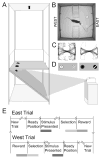Single neuron activity and theta modulation in postrhinal cortex during visual object discrimination
- PMID: 23217745
- PMCID: PMC3523310
- DOI: 10.1016/j.neuron.2012.10.039
Single neuron activity and theta modulation in postrhinal cortex during visual object discrimination
Abstract
Postrhinal cortex, rodent homolog of the primate parahippocampal cortex, processes spatial and contextual information. Our hypothesis of postrhinal function is that it serves to encode context, in part, by forming representations that link objects to places. To test this hypothesis, we recorded postrhinal neurons and local field potentials (LFPs) in rats trained on a two-choice, visual discrimination task. As predicted, many postrhinal neurons signaled object-location conjunctions. Another large proportion encoded egocentric motor responses. In addition, postrhinal LFPs exhibited strong oscillatory rhythms in the theta band, and many postrhinal neurons were phase locked to theta. Although correlated with running speed, theta power was lower than predicted by speed alone immediately before and after choice. However, theta power was significantly increased following incorrect decisions, suggesting a role in signaling error. These findings provide evidence that postrhinal cortex encodes representations that link objects to places and suggest postrhinal theta modulation extends to cognitive as well as spatial functions.
Copyright © 2012 Elsevier Inc. All rights reserved.
Conflict of interest statement
Figures







Similar articles
-
Single neuron activity and theta modulation in the posterior parietal cortex in a visuospatial attention task.Hippocampus. 2017 Mar;27(3):263-273. doi: 10.1002/hipo.22691. Epub 2017 Feb 2. Hippocampus. 2017. PMID: 27933672 Free PMC article.
-
Positional firing properties of postrhinal cortex neurons.Neuroscience. 2003;119(2):577-88. doi: 10.1016/s0306-4522(03)00160-x. Neuroscience. 2003. PMID: 12770570
-
Theta Phase Entrainment of Single-Cell Spiking in Rat Somatosensory Barrel Cortex and Secondary Visual Cortex Is Enhanced during Multisensory Discrimination Behavior.eNeuro. 2024 Apr 26;11(4):ENEURO.0180-23.2024. doi: 10.1523/ENEURO.0180-23.2024. Print 2024 Apr. eNeuro. 2024. PMID: 38621992 Free PMC article.
-
Functional neuroanatomy of the parahippocampal region in the rat: the perirhinal and postrhinal cortices.Hippocampus. 2007;17(9):709-22. doi: 10.1002/hipo.20314. Hippocampus. 2007. PMID: 17604355 Review.
-
Spatial context and the functional role of the postrhinal cortex.Neurobiol Learn Mem. 2022 Mar;189:107596. doi: 10.1016/j.nlm.2022.107596. Epub 2022 Feb 4. Neurobiol Learn Mem. 2022. PMID: 35131453 Free PMC article. Review.
Cited by
-
Neural correlates of object-associated choice behavior in the perirhinal cortex of rats.J Neurosci. 2015 Jan 28;35(4):1692-705. doi: 10.1523/JNEUROSCI.3160-14.2015. J Neurosci. 2015. PMID: 25632144 Free PMC article.
-
Conditioning sharpens the spatial representation of rewarded stimuli in mouse primary visual cortex.Elife. 2018 Sep 17;7:e37683. doi: 10.7554/eLife.37683. Elife. 2018. PMID: 30222107 Free PMC article.
-
Functional correlates of the lateral and medial entorhinal cortex: objects, path integration and local-global reference frames.Philos Trans R Soc Lond B Biol Sci. 2013 Dec 23;369(1635):20130369. doi: 10.1098/rstb.2013.0369. Print 2014 Feb 5. Philos Trans R Soc Lond B Biol Sci. 2013. PMID: 24366146 Free PMC article. Review.
-
Complementary Functional Organization of Neuronal Activity Patterns in the Perirhinal, Lateral Entorhinal, and Medial Entorhinal Cortices.J Neurosci. 2016 Mar 30;36(13):3660-75. doi: 10.1523/JNEUROSCI.4368-15.2016. J Neurosci. 2016. PMID: 27030753 Free PMC article.
-
Subcortical connections of the perirhinal, postrhinal, and entorhinal cortices of the rat. I. afferents.Hippocampus. 2016 Sep;26(9):1189-212. doi: 10.1002/hipo.22603. Epub 2016 May 24. Hippocampus. 2016. PMID: 27119220 Free PMC article.
References
-
- Aminoff E, Gronau N, Bar M. The parahippocampal cortex mediates spatial and nonspatial associations. Cereb Cortex. 2007;17:1493–1503. - PubMed
-
- Atienza M, Crespo-Garcia M, Cantero JL. Semantic congruence enhances memory of episodic associations: role of theta oscillations. J Cogn Neurosci. 2011;23:75–90. - PubMed
-
- Badre D, Wagner AD. Left ventrolateral prefrontal cortex and the cognitive control of memory. Neuropsychologia. 2007;45:2883–2901. - PubMed
Publication types
MeSH terms
Grants and funding
LinkOut - more resources
Full Text Sources
Other Literature Sources
Research Materials

